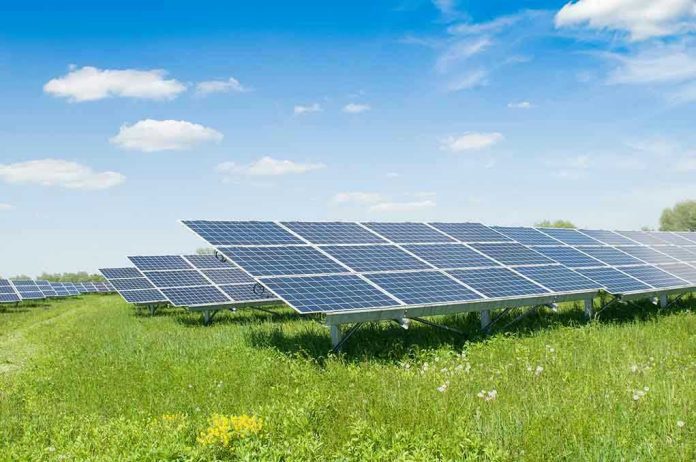
How does a $2.2 billion solar marvel become a cautionary tale of hubris, hype, and hard lessons for the future of American energy?
Story Snapshot
- The Ivanpah Solar Power Plant will begin shutting down in 2026 after years of financial losses and unmet expectations.
- Once the world’s largest solar thermal facility, Ivanpah never delivered the energy or environmental benefits promised.
- Rapid advancements in cheaper photovoltaic technology rendered Ivanpah’s costly CSP model obsolete.
- The project’s collapse exposes systemic risks in ambitious government-backed green investments.
The Rise and Fall of Ivanpah’s Desert Dream
In 2010, the Ivanpah Solar Power Plant broke ground in California’s Mojave Desert amid White House fanfare and media buzz. The project’s backers—NRG Energy, BrightSource, and Google—heralded it as a leap into the clean energy future, supported by $1.6 billion in federal loan guarantees. Ivanpah’s 170,000 mirrors were engineered to focus sunlight onto three soaring towers, boiling water to generate enough power for 140,000 homes. The promise: a technological moonshot that would prove the viability of concentrated solar power (CSP) on an epic scale. For a moment, America watched and believed.
Construction finished by late 2013, and Ivanpah began operations in 2014. But the sun quickly set on expectations. Output lagged—sometimes as low as 70% of projections. Fires, caused by misaligned mirrors, scorched the desert towers in 2016, inviting headlines and regulatory scrutiny. Environmentalists, once cheerleaders, turned critics as reports of bird deaths and disrupted habitats mounted. Within a decade, Ivanpah had become a punchline: the world’s priciest bird toaster and a case study in government’s tendency to bet big and miss.
A Perfect Storm of Economics and Environment
Ivanpah’s unraveling was not the result of a single failure but a collision of market forces, regulatory realities, and untested technology. As photovoltaic (PV) solar panels plummeted in price—dropping over 70% since the plant’s inception—the economics of Ivanpah’s CSP design looked increasingly antiquated. Utilities, under pressure to deliver savings to ratepayers, began eyeing Ivanpah’s expensive contracts as low-hanging fruit for cuts. By 2021, PG&E listed its Ivanpah deals as targets for termination. The site’s environmental toll, including the deaths of thousands of birds annually, further soured public opinion and regulatory patience.
The government’s loan guarantee, once a badge of innovation, became a political football. Officials now insist taxpayers will recover most of the loan, but exact figures remain undisclosed. Some output estimates place Ivanpah at 91% of its promised generation, others closer to 70%, fueling debate over whether the project’s technical performance was doomed by design or strangled by market upheaval. What’s not in question: Ivanpah’s model was overtaken by the relentless advance of PV solar, which now supplies power at a fraction of the cost and risk.
The Stakeholders, the Aftermath, and the Lessons for Tomorrow
Ivanpah was a triumph of coalition-building, if not technology. NRG Energy, BrightSource, and Google brought private capital and big ambitions. The U.S. Department of Energy’s backing was indispensable, making the project viable but also shifting risk to taxpayers. California’s utilities—PG&E and Southern California Edison—signed long-term contracts, their leverage growing as the economics shifted. Environmental groups that initially cheered the project later invoked it as evidence of green overreach and regulatory capture.
Decommissioning begins in 2026. Utilities may see rate savings, taxpayers hope for loan recovery, and desert wildlife may finally catch a break. Ivanpah’s towers could one day host photovoltaic arrays, a fitting twist on the march of technology. For the workers, investors, and policymakers, Ivanpah’s legacy is a hard-won lesson: the future of energy belongs to the nimble, not the grandiose. Technology, not ideology, will decide tomorrow’s winners.
What Ivanpah Means for American Energy Policy
Ivanpah’s shutdown is not merely a California story—it is a signpost for U.S. energy policy at large. The rush to build at scale with unproven technology, buoyed by government largesse and idealistic timelines, exposes taxpayers and the environment to outsized risks. Energy economist Jigar Shah argued Ivanpah succeeded only in proving CSP’s commercial limits, while PV solar quietly transformed the grid. Critics see Ivanpah as a warning against top-down mandates and a reminder that environmental goals must be matched by practical, cost-effective solutions.
The demise of Ivanpah will shape how future projects are evaluated—not just for their vision or virtue, but for their competitiveness and adaptability. As policymakers chase the next renewable breakthrough, Ivanpah’s cautionary tale will echo: every energy revolution needs both sunlight and scrutiny.
Sources:
KNPR: Ivanpah solar plant along I-15 to partially shut down
ENR: Older Ivanpah solar plant in California will close units as tech shifts
Washington Examiner: California solar plant shuts down: environmentalism, nuclear energy
Marketplace: California solar plant is riding into the sunset thanks to cheaper PV panels









